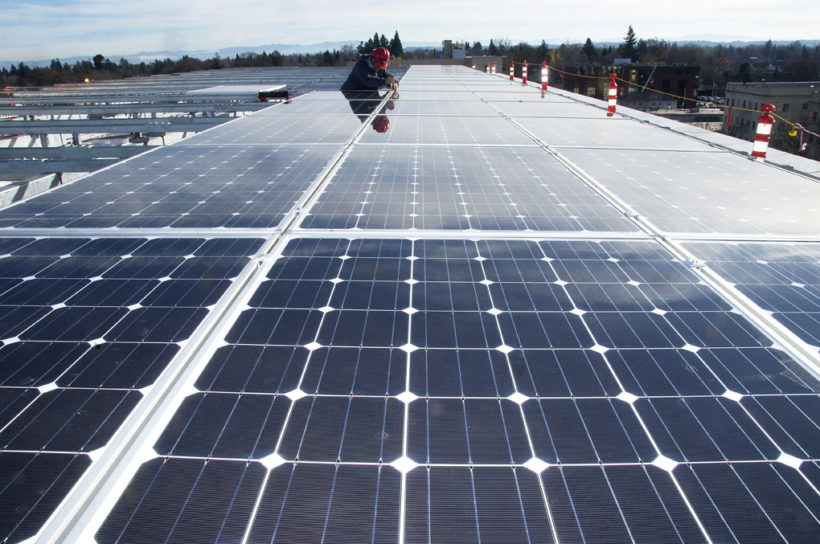 By ELIZABETH MCGOWAN
By ELIZABETH MCGOWAN
Community solar spreads in Virginia
Last month, the SCC approved three-year pilot community solar programs for four distribution co-ops served by the Old Dominion Electric Cooperative (ODEC), based in the Richmond suburb of Glen Allen. They are A&N, Mecklenburg, Northern Neck and Rappahannock. In addition, applications by two other distribution co-ops also served by Old Dominion — Shenandoah Valley and Southside — are pending before the SCC.
All six projects, which will operate under the name Cooperative Sunshare, will be available to co-op members in 50 kWh blocks, said ODEC spokeswoman Shena Crittendon.ODEC generates and transmits energy. Last year, it worked out power purchase agreements with a Dominion Energy subsidiary to buy solar power for Cooperative Sunshare participants from the 10 MW Clarke County Solar farm and the 20 MW Cherrydale Solar farm. “ODEC has taken a steady, deliberate approach to integrating renewable resources,” said ODEC CEO Marcus Harris. “It has paid off over time as we continue to pursue cost-effective options to meet our members’ needs.”
A signal that co-op community solar is more than a passing fancy in Virginia came in May when Democratic Gov. Ralph Northam showed up near Charlottesville to flip the switch on two other solar projects, Palmer and Martin, along the Interstate 64 corridor. Nearby Central Virginia Electric Cooperative is buying those projects’ 10 MW output under a 25-year power purchase agreement with Coronal Energy. Four of those MW are dedicated to CVEC co-op members enrolled in Solar Share, the co-op’s community solar program. The remainder will be spread across membership, said co-op spokeswoman Melissa Gay.
Coronal Energy, part of Panasonic, is an independent power producer focused on utility-scale solar and storage projects. Central Virginia was the first co-op community solar program that the SCC approved under the 2017 legislation. “It is critical that the Commonwealth of Virginia not be left behind as a destination for one of the fastest-growing sectors of our economy,” Northam said at the May 22 commissioning. “These projects set the example that solar energy can compete anywhere.”
DOE lights way for co-ops
Nationwide, co-ops power more than 19 million businesses, homes, school and farms. The number of them offering community solar programs grew tenfold from 19 in 2013 to 196 in 2017, according to a National Rural Electric Cooperative Association report issued in July.
Still, these recent changes are by no means a full-scale transformation among slow-to-change co-ops that are more comfortable following the lead of other utilities on renewables. Growth likely will continue only where co-ops are comfortable that solar offers the best energy value for customers.
One program that set the table for affordable solar at co-ops originated with the launch of the U.S. Department of Energy’s SunShot Initiative during the Obama administration.
SUNDA, short for Solar Utility Network Deployment Acceleration, was created in 2013 to boost solar models and resources for co-ops. An NRECA-DOE partnership shared the costs of building 30 MW of solar at 17 co-ops in 10 states. Virginia was not on that list. Through SUNDA, solar financing options grew for co-ops while the price per watt dropped. More co-ops could say yes to members demanding solar. “With SUNDA, we really saw the catalyst effect,” said Roepke, who manages the program for NRECA. “Without SUNDA, co-ops would not be on par with the rest of the industry with solar.”
Keyser finds a way
Upon initiating BARC’s community solar project in 2016, Keyser opted for a subscription-based model and capped usage at 25 percent annually so more members could participate. Instead of forcing customers to wrestle with complicated kWh, he sold the power in “blocks.” Green energy is about $1 higher per block than fossil fuels.
“Those who signed up have a fixed rate for 20 years,” he said about his 212 home and business subscribers. “That’s a nice hedge against energy cost increases.” His urge to hire a local installer led him to David Wall, president of Affordable Energy Concepts near Lynchburg. In 2017, Keyser invited Wall’s crew back to build the much larger school project.
“Mike Keyser was instrumental in us getting this job,” Wall said, adding that it’s tough for smaller companies to break into Virginia’s school solar market. “I could use a Mike Keyser at other schools.”
Keyser had two goals for the school project — fixed payments over time and to lock in today’s energy rates for two decades. He tapped into a low-interest federal relending program geared for rural energy savings. The school system borrowed $1.7 million from BARC to cover the installation costs and is now paying back that loan over 20 years.
“The schools are net metering this, so what they are paying back is coming from savings in solar production,” Keyser said. “On balance it’s a wash. If utility rates go up, this is a fixed payment and we are guaranteeing them an output of energy.” He is thrilled that Grubbs, the teacher and electrician, will be incorporating data sets collected from the school solar project into his renewable energy class. Perhaps they can eventually apply what they learn at BARC, said Keyser, as “co-ops are always looking for our employees of the future.”
Editor’s note: This article originally appeared on Energy News Network at https://energynews.us/2018/08/16/southeast/virginias-rural-co-ops-learning-lessons-with-community-solar/
Elizabeth H. McGowan is a longtime energy and environment reporter who has worked for InsideClimate News, Energy Intelligence and Crain Communications. Her groundbreaking dispatches for InsideClimate News from Kalamazoo, Mich., “The Dilbit Disaster: Inside the Biggest Oil Spill You Never Heard Of” won a Pulitzer Prize for National Reporting in 2013.



Leave a Reply